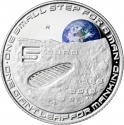You are about to finish your registration. Please check your mailbox (including spam folder). There should be a letter with a confirmation link. Check setting to make sure that your e-mail address is correct.
Send letter againDescription
Apollo 11 was the spaceflight that landed the first two people on the Moon. Commander Neil Armstrong and Lunar Module Pilot Buzz Aldrin, both American, landed the lunar module Eagle on July 20, 1969, at 20:17 UTC. Armstrong became the first person to step onto the lunar surface six hours after landing on July 21 at 02:56:15 UTC; Aldrin joined him about 20 minutes later. They spent about two and a quarter hours together outside the spacecraft, and collected 47.5 pounds (21.5 kg) of lunar material to bring back to Earth. Command Module Pilot Michael Collins piloted the command module Columbia alone in lunar orbit while they were on the Moon's surface. Armstrong and Aldrin spent 21.5 hours on the lunar surface before rejoining Columbia in lunar orbit.
Apollo 11 was launched by a Saturn V rocket from Kennedy Space Center on Merritt Island, Florida, on July 16 at 13:32 UTC, and was the fifth crewed mission of NASA's Apollo program. The Apollo spacecraft had three parts: a command module (CM) with a cabin for the three astronauts, and the only part that returned to Earth; a service module (SM), which supported the command module with propulsion, electrical power, oxygen, and water; and a lunar module (LM) that had two stages – a descent stage for landing on the Moon, and an ascent stage to place the astronauts back into lunar orbit.
Armstrong's first step onto the lunar surface was broadcast on live TV to a worldwide audience. He described the event as "one small step for [a] man, one giant leap for mankind."
Obverse
_Dollar_1/2019_06.01.2019_18.07-60.jpg)
|
Depicts the inscriptions “MERCURY,” “GEMINI,” and “APOLLO,” separated by phases of the Moon, and a footprint on the lunar surface. MERCURY GEMINI APOLLO |
|---|---|
Reverse
_Dollar_1/2019_06.01.2019_18.07_01-60.jpg)
|
Depicts a close-up of the famous ‘Buzz Aldrin on the Moon’ photograph taken July 20, 1969, that shows just the visor and part of the helmet of astronaut Buzz Aldrin. The reflection in Buzz Aldrin’s helmet includes astronaut Neil Armstrong, the United States flag, and the lunar lander. UNITED STATES OF AMERICA |
| Edge |
_Dollar_1/2019_06.01.2019_18.07.jpg)
_Dollar_1/2019_06.01.2019_18.07_01.jpg)


_Dollar_0.5/2019_06.01.2019_18.08-125.jpg)
_Dollar_0.5/2019_06.01.2019_18.08_01-125.jpg)
_Dollar_1/2019_06.01.2019_18.17-125.jpg)
_Dollar_1/2019_06.01.2019_18.17_01-125.jpg)